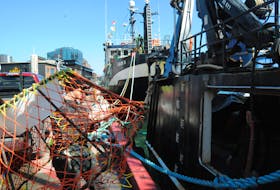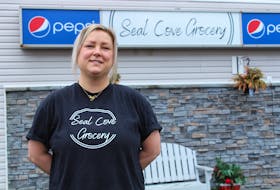“When you touched the stomach it was rock solid. It was as full as you could get.”
When Natasha Rideout took a knife and cut through the thick membrane, more than 100 small crab spilled out, along with red clumps of crab roe.
And that was just from one seal.
The seals were caught by local fish harvester Trevor Jones, hunting the ice floes off St. Anthony, several miles to the north.
Jones has been fishing for 30 years. He says it's not the first time he's seen fish and crab in seal stomachs.
"When I was younger I was sealing with my Dad, and we've seen it before."
Rideout, who manages operations for Phocalux International Inc. in the small town of Fleur De Lys, told SaltWire Network she has heard fishermen for years talk about the fish and crab they’ve found in seals' stomachs, and what she saw from Jones’s catch was stark evidence of what seals are eating.
In a news release, the company noted Jones and his crew were the only vessel participating in the adult seal harvest this year, and seals were numerous in the area he sailed.
“When cleaning the seal, the crew noticed that the stomachs were bursting with female snow crab, more than 100 in some.
“Given the recent problems with Newfoundland and Labrador snow crab stocks, the fishers thought it was important to show the public what this seal was eating, so that there would be no debate.”
The company noted there are six species of seal found off the coast of Newfoundland and Labrador, all at the highest population ever recorded, and with few natural predators.
The current quota for seals is 400,000 animals, but Rideout says only about 50,000 to 60,000 animals are taken each year.
The company also pointed out that, according to 2019 Department of Fisheries and Oceans (DFO) statistics, the current population of harp seals alone is 7.6 million.
Phocalux also points to a 1991 study of Barent’s Sea fisheries reseach (Nina Hedlund Markussen & Nils Are Øritsland, 1991) estimating an adult seal eats seven to nine kilograms of fish each day.
Yet DFO’s fishery management modelling does not include or make any connection to predation of crab or other commercial fish species by seals, the company says.
In the past, the talk of fishermen has been considered anecdotal.
But in the world of mobile phones and hand-held video technology, real evidence is becoming easier to collect and distribute.
Jones said he hopes more people will think to get photos and video of seal activitity, and stomach contents.
He knows the debate goes both ways, and that he might end up being a target of those who oppose the seal hunt.
"But that won't stop me from speaking out," said the Baie Verte Peninsula fisher.
In early February another fisherman from the area posted a video on social media of a seal stomach filled with small codfish.
It also created a flurry of comments and debate.
Bob Hardy doesn’t need convincing.
The seafood consultant from the Baie Verte Peninsula told SaltWire the research he's read, the stories he's heard from fishermen and the video evidence proves seals are having an impact on species like crab.
Hardy added that when DFO gave a technical briefing on snow crab last week, questions were posed about the impact of seals on crab.
“They said they had no evidence of seals having an impact on snow crab,” he said.
But fishermen disagree with DFO, said Hardy.
“The same presentation was given to fishers in the 2J area — off Labrador — where the snow crab stock is in terrible shape. Those guys in that meeting voiced very strongly that DFO needs to take a deeper look at snow crab.”
Hardy said he is fed up.
“I’m tired of DFO putting the blame on the lack of fish resources on fishing effort and climate," he said.
The Newfoundland and Labrador fishery should be prolific and should be the best in the world, but everyone omits one key predator, seal, and they won’t talk about it, Hardy said.
“So today is an important day because we are creating some attention and some visuals,” he said.
Hardy is also in a unique position to keep pushing that discussion.
He is a member of the Atlantic Seal Task Force that was appointed by minister Bernadette Jordan last year to gather input and make recommendations on DFO’s science activities and programs on seals and their role in the ecosystem in Atlantic Canada and Quebec.
That group was given a year to complete a final report, which is expected to be delivered to Jordan this spring.








